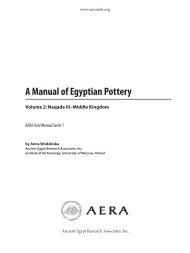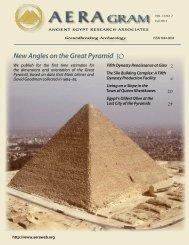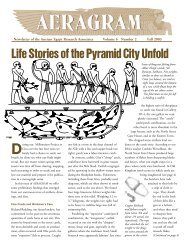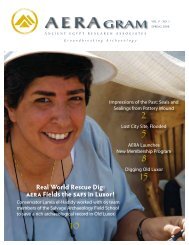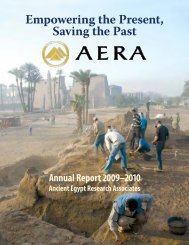The Khentkawes Town (KKT) - Ancient Egypt Research Associates
The Khentkawes Town (KKT) - Ancient Egypt Research Associates
The Khentkawes Town (KKT) - Ancient Egypt Research Associates
You also want an ePaper? Increase the reach of your titles
YUMPU automatically turns print PDFs into web optimized ePapers that Google loves.
www.aeraweb.org<br />
In addition, a narrower age-range was also given for<br />
each individual when possible. Both age group and agerange<br />
were noted on the burial forms, together with the<br />
criteria upon which the assessment was based.<br />
Due to the fragmentary nature of the <strong>KKT</strong> assemblage,<br />
only one of the burials could be aged with precision. This<br />
was the young adult male (16–21 years of age). Two burials<br />
(459 and 460) were so fragmented that no age assessment<br />
was possible at all. Of the remaining seven burials, four<br />
were Adult (18–79), and three were Senilis (50+).<br />
Sex Assessment<br />
Within all human populations, growth changes during<br />
adolescence lead to distinctive dimorphic differences in<br />
the male and female skeleton. <strong>The</strong> hipbones present the<br />
most reliable indication of sex in the human skeleton,<br />
followed by the cranium. Sex determination was therefore<br />
first and foremost based on cranial and pelvic morphology.<br />
<strong>The</strong> indicators in Table 1 were used in the analysis.<br />
All dimorphic features were scored according to<br />
Standards (Buikstra and Ubelaker 1994: 15–21) so that<br />
comparison with similar samples would be possible in<br />
the future. However, due to the poor level of preservation<br />
of the sample we could not always use all features listed<br />
above on each skeleton, but all observable traits were recorded<br />
for each individual. In addition, to complement<br />
the morphological analysis, a number of measurements<br />
were taken when obtainable. <strong>The</strong>se were as follows:<br />
Femur<br />
Humerus<br />
Sternum<br />
Vertical diameter of caput<br />
Epicondylar width<br />
(After Krogman 1962)<br />
Vertical diameter of caput<br />
Transversal diameter of caput<br />
Epicondylar width<br />
(After Sjøvold 1978, based on<br />
measurements in Gejvall 1960)<br />
Length of the manubrium<br />
Length of the meso-sternum<br />
Width of the first sternebra<br />
Width of the third sternebra<br />
(Jit et al. 1980)<br />
<strong>The</strong> results were then classified according to five different<br />
groups: Undetermined or Allophys (), Female (F),<br />
Probable female (F), Male (M), or Probable Male (M).<br />
<strong>The</strong> <strong>KKT</strong> material included two male and three female individuals,<br />
and five individuals with such poor preservation<br />
that no sex assessment was attempted.<br />
Metric Analysis<br />
Final metric analysis is pending work in the laboratory,<br />
but preliminary stature could be calculated for the two<br />
least fragmented skeletons in Burial 457. <strong>The</strong> male in<br />
457 was approximately 177.8 cm tall (between 173.6 to<br />
182 cm with error margins taken into account), and the<br />
female was approximately 166.5 cm tall (162.8 to 170.1 cm<br />
with error margins taken into account). <strong>The</strong> remaining<br />
skeletons were too fragmentary to allow for any long-bone<br />
measurements from which to calculate stature.<br />
Non-Metric Traits<br />
Non-metric traits are additional sutures, facets, bony<br />
processes, canals and foramina, that occur in a minority<br />
of skeletons and are thought to suggest diversity and<br />
familial affiliation between individuals (Saunders 1989).<br />
<strong>The</strong> only non-metric trait recorded in the <strong>KKT</strong> material<br />
was a divided hypoglossal canal in the male individual of<br />
Burial 457, skeleton [30,211].<br />
Pathological Analysis<br />
<strong>The</strong> analysis of skeletal and dental manifestations of<br />
disease can provide a vital insight into the health and<br />
diet of past populations, as well as their living conditions<br />
and occupations. Three individuals (Skeleton [29,456],<br />
Burial 454, and Skeletons [30,210] and [30,211], Burial 457)<br />
exhibited skeletal manifestations of disease.<br />
<strong>The</strong> majority of the recorded pathological lesions in the<br />
<strong>KKT</strong> material were arthritic. This is not surprising, given<br />
that arthritis is one of the three main causes of lesions in archaeological<br />
assemblages (Ortner and Putschar 1985: 545).<br />
All three individuals exhibited lesions on the spine (lipping<br />
and osteophytic growth). Vertebral osteoarthritis is directly<br />
attributable to spinal stress, and can be viewed as one of the<br />
costs of the fully erect bipedal posture of humans, in that<br />
we are more susceptible to spinal stress than quadrupedal<br />
vertebrates (Roberts and Manchester 1995: 105).<br />
Studies of relatively modern skeletal samples have<br />
shown that osteophytic growth in the spine occurred in<br />
a large proportion of the individuals by the third decade<br />
of life, and in all individuals by age 50 (Nathan 1962). An<br />
individual engaged in hard physical labor is more likely to<br />
develop osteophytic growth of the spine than a sedentary<br />
worker, and thus the more active lifestyle in antiquity probably<br />
contributed to an earlier development of vertebral osteoarthritis<br />
(Roberts and Manchester 1995: 107). In skeletal<br />
materials from <strong>Ancient</strong> <strong>Egypt</strong>, a pattern of osteoarthritis to<br />
the lower (lumbar) spine in men, and to the cervical spine<br />
in women is often observed. This has been interpreted as<br />
men engaging in more heavy lifting and hard manual labor,<br />
and women carrying heavy loads on their heads. It is interesting<br />
to note that the pattern in the <strong>KKT</strong> material is the op-<br />
Giza Occasional Papers 4 51





